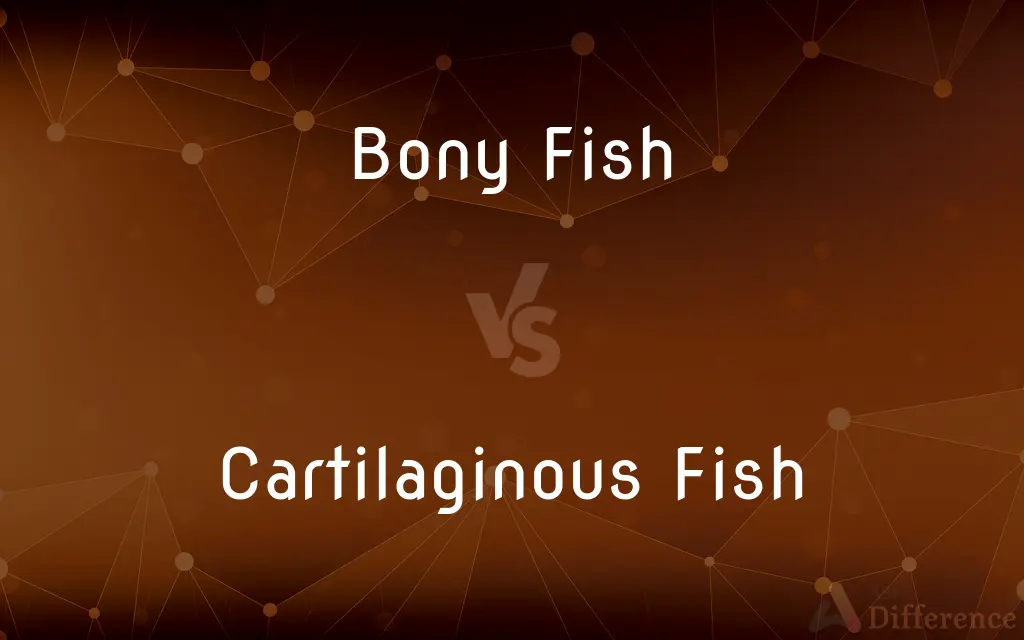Bony Fish vs. Cartilaginous Fish — What's the Difference?
By Tayyaba Rehman — Published on January 3, 2024
Bony fish have skeletons made of bone, while cartilaginous fish have skeletons made of cartilage.

Difference Between Bony Fish and Cartilaginous Fish
Table of Contents
ADVERTISEMENT
Key Differences
Bony fish, classified under the class Osteichthyes, are characterized by their rigid skeletons made of bone. In contrast, cartilaginous fish, which belong to the class Chondrichthyes, have flexible skeletons composed entirely of cartilage, the same material that shapes our ears and noses. The skeletal structure significantly affects the biology and ecology of these fish, with bony fish typically having swim bladders that aid in buoyancy, while cartilaginous fish often lack this feature and must swim to keep from sinking.
Bony fish possess a variety of scales, including cycloid, ctenoid, or ganoid, which protect their bodies. Cartilaginous fish, such as sharks and rays, are covered with placoid scales, which have a tooth-like structure that provides a hydrodynamic advantage. This difference in scale structure contributes to the diverse habitats these fish can thrive in, with bony fish found in both freshwater and marine environments, and cartilaginous fish primarily dwelling in the ocean.
Reproduction in bony fish is mostly oviparous, with females laying eggs that are then fertilized outside the body. Cartilaginous fish, however, exhibit a range of reproductive strategies; many are ovoviviparous, where eggs hatch inside the mother's body, or viviparous, with the young developing within the uterus and born live. This variation in reproductive methods reflects their adaptability to different marine environments and ecological niches.
When it comes to feeding, bony fish exhibit a wide range of diets from plants to other fish, and they have well-developed jaws and teeth for capturing and processing their food. Cartilaginous fish, especially sharks, are often apex predators with powerful jaws and sharp, replaceable teeth, suited for a diet primarily consisting of meat, though some species like the whale shark feed on plankton filtered from the water.
In terms of sensory capabilities, bony fish generally have a lateral line system sensitive to vibrations and a swim bladder that can function in sound transmission. Cartilaginous fish lack a swim bladder but possess a highly developed lateral line system and, in some species, electroreceptors called ampullae of Lorenzini, which allow them to detect the electric fields produced by prey. The sensory adaptations of both bony and cartilaginous fish highlight their evolutionary divergence and specialization within aquatic environments.
ADVERTISEMENT
Comparison Chart
Skeleton Composition
Bone
Cartilage
Buoyancy Mechanism
Swim bladder
Lack of swim bladder
Gill Covering
Operculum (gill cover)
Exposed gill slits
Scale Type
Overlapping
Placoid, not overlapping
Reproduction
Mostly oviparous
Many are viviparous
Compare with Definitions
Bony Fish
Have overlapping scales.
The bony fish displayed its shiny scales.
Cartilaginous Fish
Fish with cartilage skeletons.
Sharks are well-known cartilaginous fish.
Bony Fish
Possess swim bladders.
The bony fish used its swim bladder to ascend.
Cartilaginous Fish
Lack swim bladders.
The cartilaginous fish relied on its fins for buoyancy.
Bony Fish
Have operculum covering gills.
The trout, a bony fish, has a visible operculum.
Cartilaginous Fish
Many are viviparous.
Some cartilaginous fish give birth to live young.
Bony Fish
Fish with bony skeletons.
Salmon are a popular type of bony fish.
Cartilaginous Fish
Possess placoid scales.
The rough skin of the cartilaginous fish is due to placoid scales.
Bony Fish
Mostly oviparous.
Many bony fish lay eggs.
Cartilaginous Fish
Have exposed gill slits.
The gill slits are visible in the cartilaginous fish.
Common Curiosities
Define Cartilaginous Fish.
Fish with a skeleton made of cartilage.
Do Bony Fish have swim bladders?
Yes, most bony fish have swim bladders.
What is a Bony Fish?
Fish with a skeleton made of bone.
What type of scales do Bony Fish have?
They have overlapping scales.
Can you give an example of a Bony Fish?
Trout is an example of a bony fish.
Do Cartilaginous Fish have swim bladders?
No, they lack swim bladders.
How are the gills of Cartilaginous Fish arranged?
They have exposed gill slits.
Are Cartilaginous Fish typically oviparous or viviparous?
Many are viviparous, giving birth to live young.
Are Bony Fish typically oviparous or viviparous?
Most are oviparous, laying eggs.
What covers the gills of Bony Fish?
An operculum covers their gills.
What are the scales like on Cartilaginous Fish?
They have placoid, non-overlapping scales.
Do Bony Fish have flexible skeletons?
Their skeletons are rigid due to being made of bone.
Are the skeletons of Cartilaginous Fish flexible?
Yes, their cartilage skeletons are more flexible.
Can you name a Cartilaginous Fish?
Sharks are examples of cartilaginous fish.
Which group has more species diversity, Bony or Cartilaginous Fish?
Bony fish have more species diversity.
Share Your Discovery

Previous Comparison
Yeast vs. Mould
Next Comparison
In Situ vs. Ex SituAuthor Spotlight
Written by
Tayyaba RehmanTayyaba Rehman is a distinguished writer, currently serving as a primary contributor to askdifference.com. As a researcher in semantics and etymology, Tayyaba's passion for the complexity of languages and their distinctions has found a perfect home on the platform. Tayyaba delves into the intricacies of language, distinguishing between commonly confused words and phrases, thereby providing clarity for readers worldwide.
















































